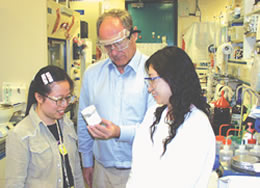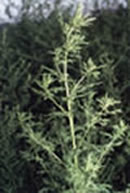.gif)
|
“It was a remarkable breakthrough,” said Principal Investigator Prof Richard K Haynes “not only because they could isolate the compound so effectively but because of its unusual structure.” Through a chemical reduction process, the Chinese converted artemisinin into three derivatives which are now used in frontline treatment of malaria around the world. Malaria parasites are transmitted to humans by mosquitoes and, once in the blood, cause symptoms such as fever, anaemia, chills and in severe cases, coma and death. “These artemisinin derivatives are the best drugs today for treating malaria because they kill the parasite very quickly,” said Prof Haynes. One problem, however, is that the drugs break down quickly in the body to produce a principal metabolite which has proved to be toxic when tested on brain cells taken from animals such as dogs and rats. The substance responsible is dihydro artemisinin which still has the major part of the artemisinin structure intact. “It cannot be said that these compounds are neurotoxic in patients,” said Prof Haynes. Putting cells into a Petri dish is very different to taking a drug because the drug obviously has to get into the brain. “What is important is that in a Western drug regulatory environment, drugs are put through all possible toxicity tests before being cleared.” Using medicinal chemistry, Prof Haynes converted artemisinin into a non-toxic derivative, changing the parent structure from lipophilic, or fat-loving, to more hydrophilic, or water-loving. “A lipophilic drug is like a tiny lump of fat and will easily go through the blood-brain barrier which is a membrane of fatty layers,” he said. “The same fatty layers repel water so, by making the drug more hydrophilic, it doesn’t really want to go through the fatty membrane.” It is also important that the compound does not break down in the body to dihydroartemisinin. To arrive at the non-toxic version of the drug, about 300 compounds were made. The method of producing the new derivative, called artemisone, involves two chemical reactions in a single process. The process has been used on a pilot scale by a European pharmaceutical company to produce more than 100 kg of the drug. As well as showing no signs of neurotoxicity, the new drug is more active with only one-third of the dose required compared to its predecessors to cure malaria patients. Principal Investigator Prof Richard K Haynes : Haynes@ust.hk |
||||||||||||||||||||||||


